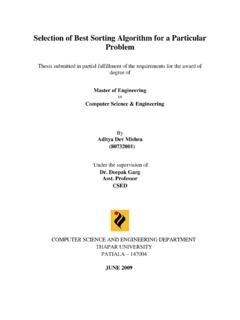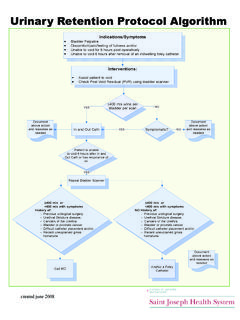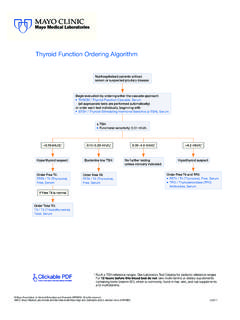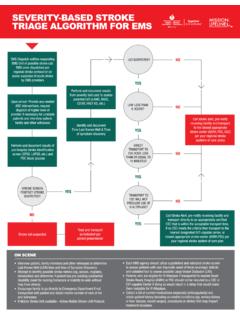Transcription of Adam: A Method for Stochastic Optimization - arXiv
1 Published as a conference paper at ICLR 2015 ADAM: A Method FORSTOCHASTICOPTIMIZATIOND iederik P. Kingma*University of Amsterdam, Lei Ba University of introduceAdam, an algorithm for first-order gradient-based Optimization ofstochastic objective functions, based on adaptive estimates of lower-order mo-ments. The Method is straightforward to implement, is computationally efficient,has little memory requirements, is invariant to diagonal rescaling of the gradients,and is well suited for problems that are large in terms of data and/or Method is also appropriate for non-stationary objectives and problems withvery noisy and/or sparse gradients.
2 The hyper-parameters have intuitive interpre-tations and typically require little tuning. Some connections to related algorithms,on whichAdamwas inspired, are discussed. We also analyze the theoretical con-vergence properties of the algorithm and provide a regret bound on the conver-gence rate that is comparable to the best known results under the online convexoptimization framework. Empirical results demonstrate that Adam works well inpractice and compares favorably to other Stochastic Optimization methods. Finally,we discussAdaMax, a variant ofAdambased on the infinity gradient-based Optimization is of core practical importance in many fields of science andengineering.
3 Many problems in these fields can be cast as the Optimization of some scalar parameter-ized objective function requiring maximization or minimization with respect to its parameters. If thefunction is differentiable its parameters, gradient descent is a relatively efficient optimizationmethod, since the computation of first-order partial derivatives all the parameters is of the samecomputational complexity as just evaluating the function. Often, objective functions are example, many objective functions are composed of a sum of subfunctions evaluated at differentsubsamples of data; in this case Optimization can be made more efficient by taking gradient individual subfunctions, Stochastic gradient descent (SGD) or ascent.
4 SGD proved itselfas an efficient and effective Optimization Method that was central in many machine learning successstories, such as recent advances in deep learning (Deng et al., 2013; Krizhevsky et al., 2012; Hinton& Salakhutdinov, 2006; Hinton et al., 2012a; Graves et al., 2013). Objectives may also have othersources of noise than data subsampling, such as dropout (Hinton et al., 2012b) regularization. Forall such noisy objectives, efficient Stochastic Optimization techniques are required. The focus of thispaper is on the Optimization of Stochastic objectives with high-dimensional parameters spaces.
5 Inthese cases, higher-order Optimization methods are ill-suited, and discussion in this paper will berestricted to first-order proposeAdam, a Method for efficient Stochastic Optimization that only requires first-order gra-dients with little memory requirement. The Method computes individual adaptive learning rates fordifferent parameters from estimates of first and second moments of the gradients; the nameAdamis derived from adaptive moment estimation. Our Method is designed to combine the advantagesof two recently popular methods: AdaGrad (Duchi et al.)
6 , 2011), which works well with sparse gra-dients, and RMSProp (Tieleman & Hinton, 2012), which works well in on-line and non-stationarysettings; important connections to these and other Stochastic Optimization methods are clarified insection 5. Some of Adam s advantages are that the magnitudes of parameter updates are invariant torescaling of the gradient, its stepsizes are approximately bounded by the stepsize hyperparameter,it does not require a stationary objective, it works with sparse gradients, and it naturally performs aform of step size annealing.
7 Equal contribution. Author ordering determined by coin flip over a Google [ ] 30 Jan 2017 Published as a conference paper at ICLR 2015 algorithm 1:Adam, our proposed algorithm for Stochastic Optimization . See section 2 for details,and for a slightly more efficient (but less clear) order of the elementwisesquaregt gt. Good default settings for the tested machine learning problems are = , 1= , 2= = 10 8. All operations on vectors are element-wise. With t1and t2we denote 1and 2to the : : StepsizeRequire: 1, 2 [0,1): Exponential decay rates for the moment estimatesRequire:f( ): Stochastic objective function with parameters Require: 0.]
8 Initial parameter vectorm0 0(Initialize 1stmoment vector)v0 0(Initialize 2ndmoment vector)t 0(Initialize timestep)while tnot convergeddot t+ 1gt ft( t 1)(Get gradients Stochastic objective at timestept)mt 1 mt 1+ (1 1) gt(Update biased first moment estimate)vt 2 vt 1+ (1 2) g2t(Update biased second raw moment estimate) mt mt/(1 t1)(Compute bias-corrected first moment estimate) vt vt/(1 t2)(Compute bias-corrected second raw moment estimate) t t 1 mt/( vt+ )(Update parameters)end whilereturn t(Resulting parameters)In section 2 we describe the algorithm and the properties of its update rule.
9 Section 3 explainsour initialization bias correction technique, and section 4 provides a theoretical analysis of Adam sconvergence in online convex programming. Empirically, our Method consistently outperforms othermethods for a variety of models and datasets, as shown in section 6. Overall, we show that Adam isa versatile algorithm that scales to large-scale high-dimensional machine learning algorithm 1 for pseudo-code of our proposed algorithmAdam. Letf( )be a noisy objec-tive function: a Stochastic scalar function that is differentiable parameters.
10 We are in-terested in minimizing the expected value of this function,E[f( )] its parameters . Withf1( ),..,,fT( )we denote the realisations of the Stochastic function at subsequent timesteps1,..,T. The stochasticity might come from the evaluation at random subsamples (minibatches)of datapoints, or arise from inherent function noise. Withgt= ft( )we denote the gradient, vector of partial derivatives offt, evaluated at algorithm updates exponential moving averages of the gradient (mt) and the squared gradient(vt) where the hyper-parameters 1, 2 [0,1)control the exponential decay rates of these movingaverages.]

![arXiv:0706.3639v1 [cs.AI] 25 Jun 2007](/cache/preview/4/1/3/9/3/1/4/b/thumb-4139314b93ef86b7b4c2d05ebcc88e46.jpg)

![arXiv:1301.3781v3 [cs.CL] 7 Sep 2013](/cache/preview/4/d/5/0/4/3/4/0/thumb-4d504340120163c0bdf3f4678d8d217f.jpg)
![@google.com arXiv:1609.03499v2 [cs.SD] 19 Sep 2016](/cache/preview/c/3/4/9/4/6/9/b/thumb-c349469b499107d21e221f2ac908f8b2.jpg)










